Sarah Sundin's Blog, page 219
June 6, 2018
Cover Reveal – The Sky Above Us
 Today, on the 74th anniversary of the D-Day landings, I’m pleased to reveal the cover for my upcoming D-Day novel The Sky Above Us, Book 2 in the Sunrise at Normandy series.
Today, on the 74th anniversary of the D-Day landings, I’m pleased to reveal the cover for my upcoming D-Day novel The Sky Above Us, Book 2 in the Sunrise at Normandy series.
Today on 6/6, I’m giving away 6 books – the winner’s choice of The Sea Before Us (paperback), The Sea Before Us audiobook, or The Sky Above Us when it releases in February 2019.
The book is now available for pre-order at Amazon, and will be available on other sites soon. Pre-orders for the e-book and audiobook will be available at a later date.
Sunrise at Normandy Series
One fateful night drove three brothers apart.
One fateful day thrusts them together…D-Day.
The Sky Above Us
(Book 2, coming February 5, 2019)
Secrets as vast . . .
Love as unreachable . . .
As the sky above them.
Numbed by grief and harboring shameful secrets, Lt. Adler Paxton ships to England with the US 357th Fighter Group in late 1943. Determined to become an ace P-51 Mustang pilot, Adler battles the German Luftwaffe in treacherous dogfights over France as the Allies struggle for control of the air before the D-day invasion.
Violet Lindstrom wants to be a missionary, but for now she serves in the American Red Cross, where she arranges entertainment and refreshments for the men of the 357th in the base Aeroclub and sets up programs for local children. Drawn to the mysterious Adler, she enlists his help with her work and urges him to reconnect with his family after a long estrangement.
Despite himself, Adler finds his defenses crumbling when it comes to Violet. But D-day draws near. And secrets can’t stay buried forever.
Return to the shores of Normandy, this time in the air, as the second Paxton brother faces the past—and the most fearsome battle of his life.
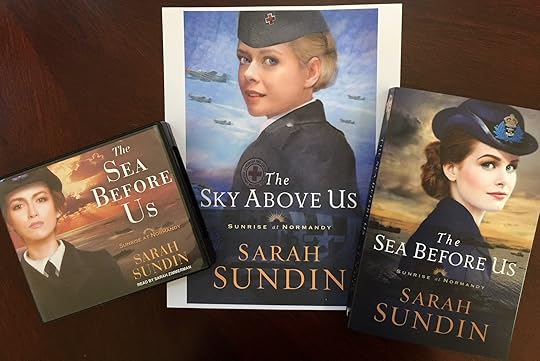 Giveaway
GiveawayTo enter the giveaway, enter the Rafflecopter below (US mailing addresses only please). Giveaway ends Sunday, June 10, 2018 at midnight Pacific Time. I’ll announce the six winners here on Monday, June 11, 2018 and by email.
Today in World War II History—June 6, 1943
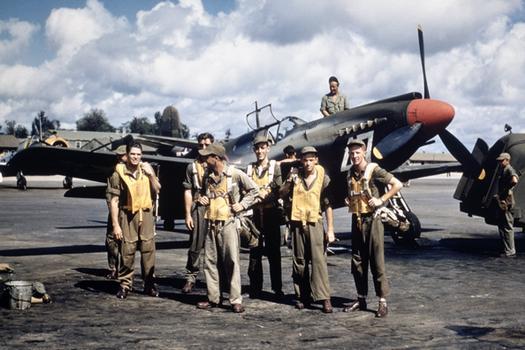
US pilots training to fly the North American A-36A Apache, Louisiana, 1943 (US Army Air Force photo)
75 Years Ago—June 6, 1943: North American A-36 Apache (fighter-bomber version of the P-51 Mustang) flies first combat mission in US Twelfth Air Force mission to Pantelleria in the Mediterranean.
Future actor Paul Newman enlists in US Navy, age 18.
June 5, 2018
Today in World War II History—June 5, 1943
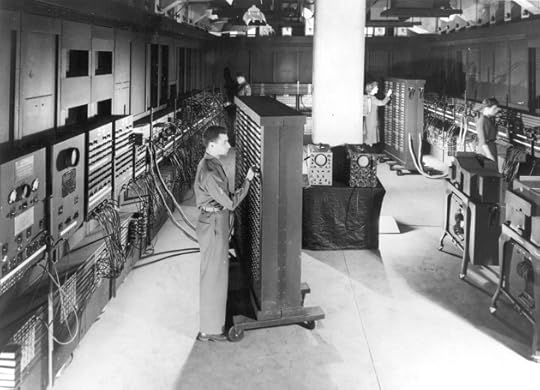
Cpl. Irwin Goldstein sets switches on one of the ENIAC’s function tables at the Moore School of Electrical Engineering, University of Pennsylvania, 1946 (US Army photo)
75 Years Ago—June 5, 1943: Aircraft from escort carrier USS Bogue sink German U-boat U-217 in the mid-Atlantic.
US Army signs contract with the University of Pennsylvania to develop the first all-electronic computer, ENIAC (Electronic Numerical Integrator and Computer).
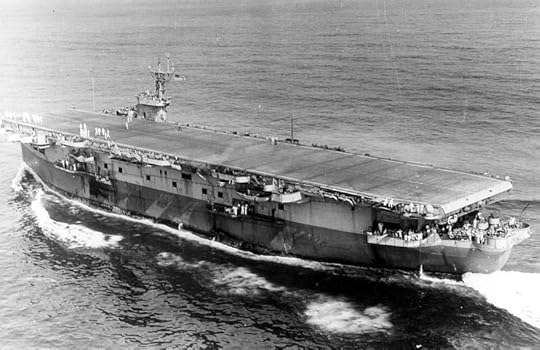
Auxiliary carrier USS Bogue (ACV-9) near Norfolk, VA, 20 June 1943 (US Navy photo)
June 4, 2018
Today in World War II History—June 4, 1943

US poster for United China Relief, WWII
75 Years Ago—June 4, 1943: Luftwaffe bombs Gorky, Russia in first German strategic air raid against Soviet industrial centers.
Chinese launch assault against Japanese in the Hubei-Hunan region of China.
June 3, 2018
Today in World War II History—June 3, 1943
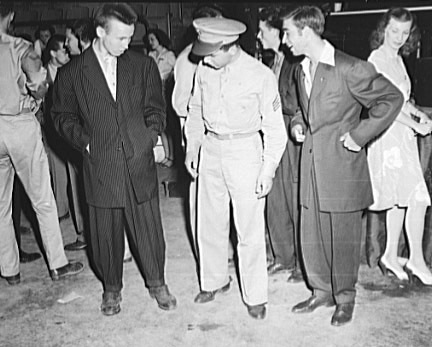
Soldier inspecting zoot suits at the Uline Arena, Washington DC, 1942 (Library of Congress)
75 Years Ago—June 3, 1943: Zoot Suit Riots begin—US Navy sailors and Mexican-Americans scuffle in Los Angeles, as servicemen resent flamboyant “unpatriotic” clothing of Latino youth; over the next several days over 150 people will be injured.
French Committee for National Liberation formed in Algiers, Algeria, under joint leadership of former rivals Generals Charles de Gaulle and Henri Giraud.
Patent filed by American engineer Hurley Smith for the first plastic pocket protector.
June 2, 2018
Today in World War II History—June 2, 1943
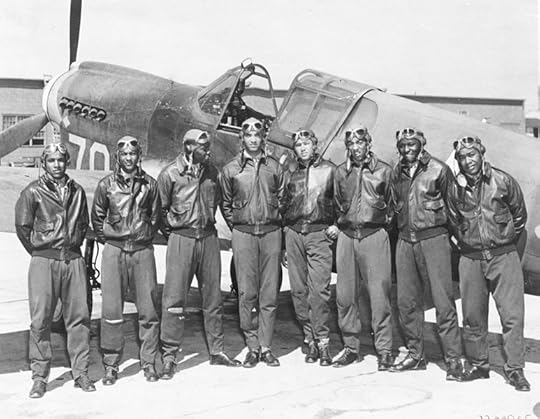
Men of the US 99th Fighter Squadron (“Tuskegee Airmen”) and a P-40 fighter in North Africa, 1943 (US Air Force photo)
75 Years Ago—June 2, 1943: Combat debut of US 99th Fighter Squadron, the first African-American squadron (“Tuskegee Airmen”), in Twelfth Air Force mission from Tunisia to island of Pantelleria.
June 1, 2018
Today in World War II History—June 1, 1943

Publicity photo of Leslie Howard for Gone with the Wind, 1939 (public domain via Wikipedia)
75 Years Ago—June 1, 1943: British actor Leslie Howard (Gone With the Wind) is killed when a German Ju 88 shoots down his DC-3 airliner flying from Portugal to England.
Col. Florence Blanchfield becomes superintendent of the US Army Nurse Corps.
Frank Sinatra signs with Columbia Records as a solo artist.
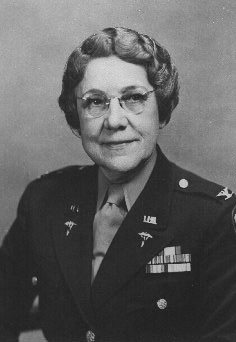
Col. Florence Blanchfield, US Army Nurse Corps (US War Department photo)
May 31, 2018
Today in World War II History—May 31, 1943
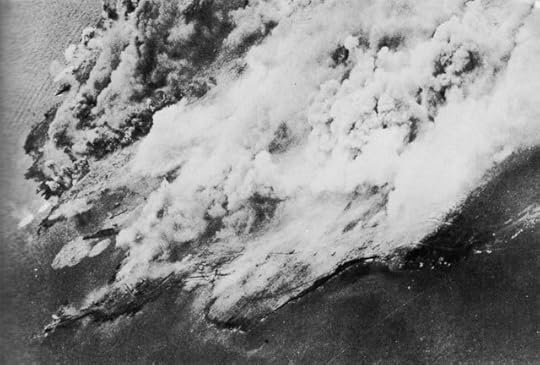
Allied air raid on Pantelleria Island in the Mediterranean, May-June 1943 (US Army Air Force photo)
75 Years Ago—May 31, 1943: British ships begin naval bombardment of Pantelleria between Tunisia and Sicily, adding to the aerial bombardment started May 18.
Movie premiere of Cole Porter musical Du Barry Was a Lady, starring Red Skelton, Lucille Ball, Virginia O’Brien, and Gene Kelly.
“Archie” comics first broadcast on radio.
May 30, 2018
Today in World War II History—May 30, 1943
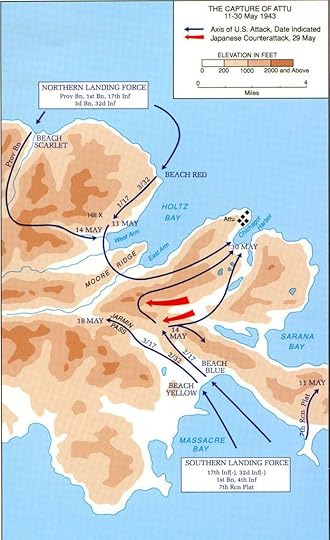
Map of US Army operations on Attu in the Aleutians, May 1943 (US Army Center of Military History)
75 Years Ago—May 30, 1943: US Army secures Attu in the Aleutians, 700 Americans and 2600 Japanese killed (only 29 surrender).
Dr. Josef Mengele, “the angel of death,” arrives at Auschwitz.
All-American Girls Baseball League begins first 108-game season with 4 teams (Rockford, Kenosha, Racine, South Bend).
May 29, 2018
A Tribute to Rosie the Riveter

US poster by J. Howard Miller, 1943
Rosie the Riveter has come to represent the women of World War II. We all love Rosie. She’s strong but cute. She has biceps, but she curls her hair and does her nails. And look at that chin—she won’t let anyone tell her what she can or can’t do. She is woman; hear her riveting gun.
The 1940 census counted 132 million people in the USA. During the war, 11 million men and women served in the armed forces. Even if the economy had continued at its pre-war level, that would have caused a significant drop in the workforce. But with the enormous increase in production, more workers were desperately needed. And that meant women.
Recruiting Rosie

US poster, WWII
American industry actively recruited women to work in war jobs, and women’s war work was praised in songs, posters, advertisements, and movies. The “We Can Do It” poster by J. Howard Miller was introduced February 15, 1943 for a two-week in-house campaign at Westinghouse. At the time, the poster wasn’t seen nationwide at the time, nor was it associated with “Rosie.” Not until the 1980s was the poster rediscovered and embraced.
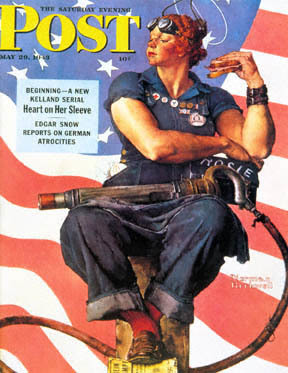
Norman Rockwell’s “Rosie the Riveter” on the cover of the Saturday Evening Post, 29 May 1943 (Fair use via Wikipedia)
The song “Rosie the Riveter” (Redd Evans/John Jacob Loeb, copyright 1942), praised the girl on the assembly line and was recorded by Kay Kyser, the Four Vagabonds, and others.
On May 29, 1943, Norman Rockwell’s “Rosie the Riveter” painting appeared on the cover of The Saturday Evening Post, most likely inspired by the song. Rosie’s foot stamps out Hitler’s Mein Kampf, a riveting gun lies across her lap, and “Rosie” is printed on her lunchbox. On April 9, 1944, a feature film called Rosie the Riveter was released, starring Jane Frazee.
Rosie the Riveter has come to represent all women who contributed to the war effort by stepping into men’s work boots.
Challenges for Rosie
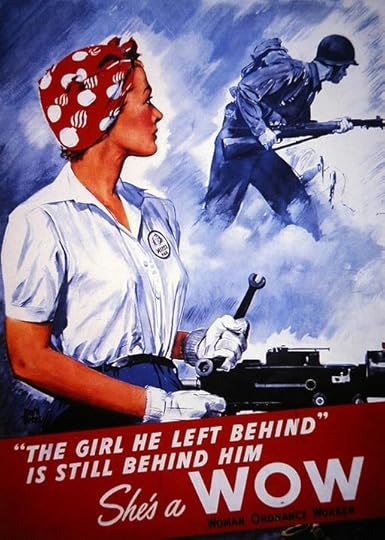
US poster recruiting Women Ordnance Workers, WWII
During the war, 19 million women held jobs outside of the home, up from 12 million in 1940—6 million were working outside the home for the first time. Thirty percent of working women worked in factories as Rosie the Riveter and Wendy the Welder. At first, they faced much opposition. Some believed women wouldn’t be capable of performing men’s jobs, and some were convinced the women were there to seduce the men. However, Rosie and her friends proved to be able workers—and were even preferred in some jobs that benefitted from women’s smaller fingers and attention to detail.
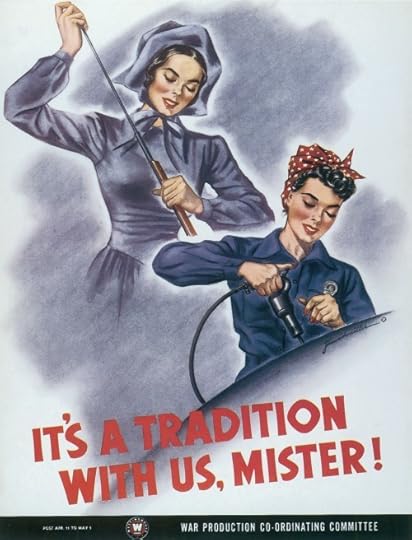
US poster by J. Howard Miller, WWII
They faced other challenges. While 2.75 million working women had children under the age of fourteen, day care was not available early in the war. Mothers relied on relatives or friends—or left the children unattended. Movie theaters reported an unsettling trend of young children left all day at the movies unsupervised. Savvy employers began to provide on-site day care, and centers were also established at schools.
Women struggled for equal treatment. Although the War Labor Board decreed in April 1943 that women in war jobs were to receive equal work for equal pay, the average wage for female workers remained significantly lower. As the newest employees on the job, women lacked seniority under union rules and were mostly stuck with the swing swift—an extra problem for mothers with young children at home.
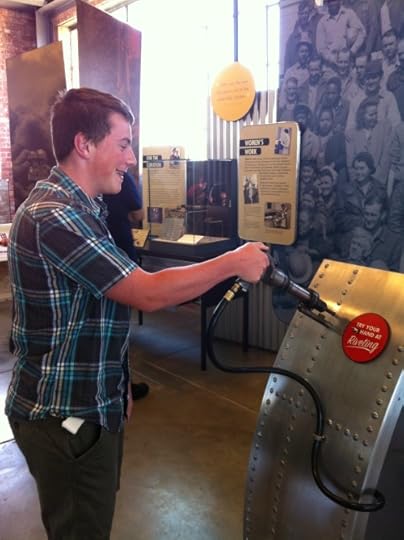
My son humoring his mother and operating the riveting gun exhibit at the Rosie the Riveter WWII Home Front Museum, Richmond, CA (May 2014)
Honoring Rosie
Women played an important role in the extraordinary increase in production during the war, contributing to the “Arsenal of Democracy” that helped win the war for the Allies.
Today Rosies are honored at the Rosie the Riveter WWII Home Front National Historical Park in Richmond, CA, located at the site of the Kaiser Shipyards where many of these women worked. The museum has excellent exhibits about women at work—and many Rosies serve as docents!
Here’s to all the Rosies! They could do it!
Selected sources:
Lingeman, Richard R. Don’t You Know There’s a War on? The American Home Front 1941-1945. New York: G.P. Putnam’s Sons, 1970.



